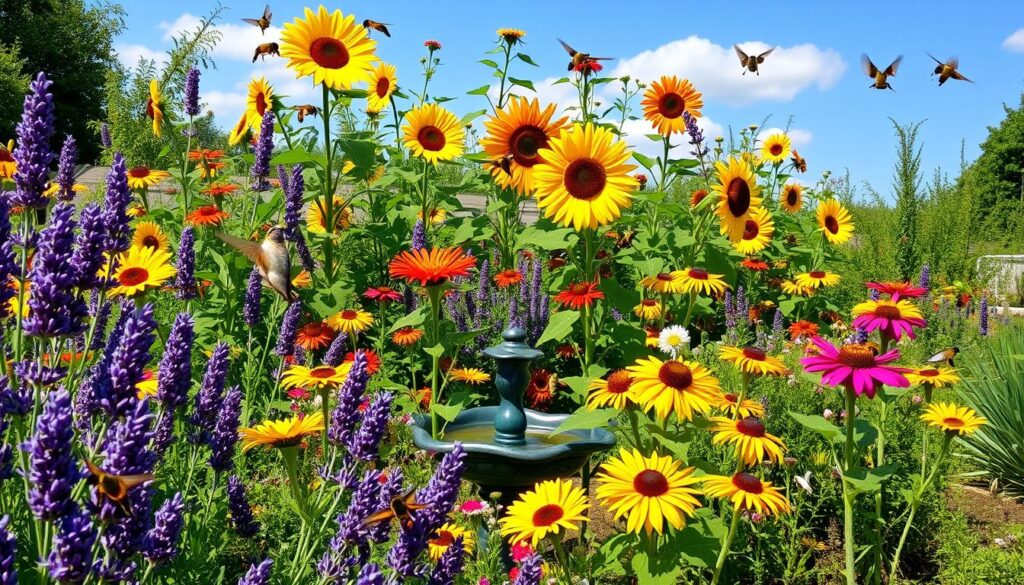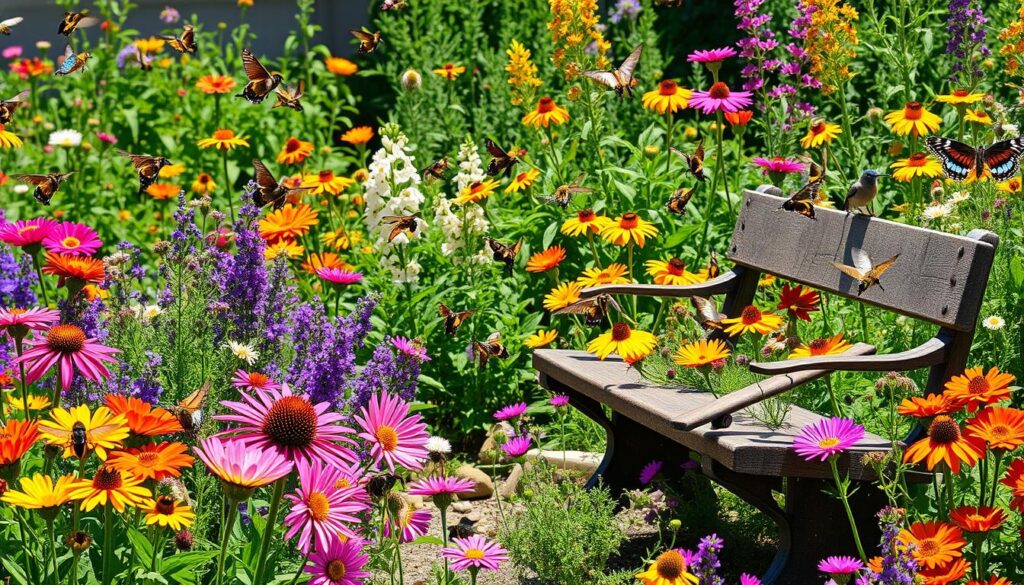Ever thought about how a garden can become a lively place? By choosing the right plants, you can make your garden a haven for bees and butterflies. This not only supports these creatures but also makes your garden more beautiful.
By picking bee-friendly flowers and plants that attract butterflies, you help nature thrive. This also brings peace and joy to your outdoor space. Let’s dive into how you can make your garden a welcoming place for these important visitors.
Key Takeaways
- Understanding the significance of pollinators in our ecosystem.
- Recognizing the characteristics of plants that attract beneficial insects.
- Exploring various annual and perennial plants that are ideal for pollinators.
- Learning how to create habitats that provide shelter and food for pollinators.
- Planning your garden layout to ensure a continuous food supply for these vital creatures.
Understanding the Importance of Pollinators
Pollinators are key to our ecosystems, helping plants reproduce. They move pollen from flower to flower. This is vital for growing fruits, veggies, and flowers. Knowing about pollinators helps us see their role in keeping our ecosystems healthy.
What Are Pollinators?
Pollinators help move pollen between flowers, making plants grow. This is crucial for seeds and fruits. Bees, butterflies, birds, and bats are all important for our food and nature.
Why They Matter for the Ecosystem
Pollinators show how healthy our ecosystems are. They create homes and food for many animals. Without them, we’d lose a third of our food and biodiversity.
Common Types of Pollinators
Knowing about different pollinators is fascinating. Here’s a quick look at some:
| Type of Pollinator | Examples | Flowers They Prefer |
|---|---|---|
| Bees | Bumblebees, Honeybees | Sunflowers, Lavender |
| Butterflies | Monarchs, Swallowtails | Milkweed, Lantana |
| Birds | Hummingbirds | Columbine, Trumpet Vine |
| Bats | Fruit Bats | Night-Blooming Cereus, Agave |
Characteristics of Pollinator-Friendly Plants
Knowing what makes plants good for pollinators is key to a great garden. Plants that attract pollinators have bright colors, sweet smells, and offer nectar and pollen. Choosing native plants helps create a better home for local pollinators.
Bright Colors and Fragrant Blooms
Flowers in bold colors grab the attention of bees and butterflies. Their sweet smells are like a welcome sign for these visitors. These traits are crucial for drawing pollinators to your garden.
Nectar and Pollen Sources
Nectar and pollen are vital for pollinators’ survival. Plants that offer these help the pollinator population grow. This supports a healthy garden ecosystem.
Native vs. Non-Native Plants
Native plants are better for your garden because they fit the local environment perfectly. They provide what local insects need. Non-native plants might look good but don’t always help local wildlife.
| Feature | Native Pollinator Plants | Non-Native Plants |
|---|---|---|
| Adaptation | Well-adapted to local soil and climate | Might struggle to thrive without specific conditions |
| Support for Pollinators | Supports local pollinators effectively | May not attract local pollinator species |
| Nutritional Value | Rich in nectar and pollen | Some may lack sufficient food resources for pollinators |
| Aesthetic Appeal | Varies with local beauty | Often vibrant and colorful, but may not benefit wildlife |
Top Pollinator-Friendly Annuals to Plant
Choosing the right annual plants can turn your garden into a vibrant haven for pollinators. Some species add color and nourishment for bees and butterflies. Here are some top picks to consider.
Sunflowers
Sunflowers are top choices for pollinators, with their large, bold blooms. Their bright yellow petals are stunning, and they offer a feast for bees and butterflies. They love sunny spots, making them great for gardens.
Zinnias
Zinnias are a favorite among gardeners, easy to grow and come in many colors. They bloom a lot, offering nectar all season. Plus, they resist pests and diseases, making them reliable in any garden.
Cosmos
Cosmos are great for their long blooming periods. They’re colorful and feed many pollinators. Their delicate petals add grace and charm to gardens, attracting butterflies.
| Flower Type | Nectar Source | Attracts | Sunlight Requirements |
|---|---|---|---|
| Sunflowers | Abundant | Bees, butterflies | Full sun |
| Zinnias | Consistent | Bees | Full sun |
| Cosmos | Moderate | Butterflies | Full sun |
Perennial Plants That Attract Pollinators
Choosing the right perennial pollinator plants is key for a lively garden. These plants attract beneficial insects and add beauty to your outdoor space. They provide essential resources for bees and butterflies all year round. Here are three top picks that are both beautiful and pollinator-friendly.
Coneflowers
Coneflowers, or Echinacea, grow well in many conditions. They come in pink, purple, and white, making your garden colorful. These flowers are a big hit with bees because they have lots of nectar.
Black-eyed Susans
Black-eyed Susans (Rudbeckia) bloom in bright yellow in late summer. They add a pop of color to any garden. These bee-friendly perennials attract many pollinators and are easy to care for. They’re great for those who want beautiful, long-lasting flowers.
Lavender
Lavender is not just fragrant but also attracts bees and butterflies. It needs little care and loves sunny spots. Its purple flowers and scent make it a standout choice among long-lasting pollinator flowers.
| Plant Name | Color | Nectar Source | Bloom Time |
|---|---|---|---|
| Coneflowers | Pink, Purple, White | High | Summer |
| Black-eyed Susans | Yellow | Moderate | Late Summer |
| Lavender | Purple | High | Summer |
Shrubs and Trees Beneficial for Pollinators
Adding beneficial shrubs and trees to your garden is great for pollinators. These plants make your garden look beautiful and provide food for pollinators. Let’s explore some of the best options.
Butterfly Bush
The Butterfly Bush (Buddleia) blooms for a long time, attracting many pollinators. Its colorful flowers are a great source of nectar in summer. This shrub is perfect for attracting butterflies, bees, and other beneficial insects.
Serviceberry
Serviceberry trees bloom early in spring, offering nectar and fruit to pollinators. They also have berries that birds love. The blossoms and berries are key to the food web, helping pollinators and wildlife.
Oaks and Maples
Oaks and Maples are stunning in any garden and vital for pollinators. They support many insects at different stages of their lives. Their flowers feed pollinators in spring, and their leaves provide shelter. Oaks also offer acorns, a vital food for wildlife.
| Plant Type | Pollinator Attraction | Other Benefits |
|---|---|---|
| Butterfly Bush | Attracts butterflies and bees | Long-lasting blooms and fragrance |
| Serviceberry | Attracts early spring pollinators | Provides berries for birds and wildlife |
| Oaks | Supports various insects and pollinators | Acorns for wildlife; shelter |
| Maples | Pollinators in early spring | Dense canopies for shelter |
Choosing the right shrubs and trees can make your garden a haven for pollinators. It also makes your outdoor space more beautiful and rich.
Creating a Habitat for Pollinators
To welcome pollinators, we must understand their needs. We need to make smart choices in our gardens. This means providing shelter, water, and avoiding harmful pesticides. These steps are crucial for protecting pollinators.
Providing Shelter and Food
A vibrant garden is key for pollinators. It should have a variety of plants for shelter and food. Dense plantings offer cozy spots for nesting and safety from predators.
Choose a mix of flowers, shrubs, and native trees. This attracts different pollinators and keeps food sources available all season.
Water Sources for Pollinators
Water is essential for all living things, including pollinators. Create small water features like birdbaths or shallow dishes. Add stones or pebbles for bees and butterflies to rest and drink.
Keep these water sources clean and fresh. This will encourage pollinators to visit often.
Avoiding Pesticides
Using pesticides can harm pollinators. These chemicals are dangerous to their health and populations. Instead, use natural methods like companion planting and attracting beneficial insects.
This approach helps keep your garden balanced and safe for pollinators.

How to Plan Your Garden Layout
Planning your garden well is key for a healthy pollinator garden. Knowing your garden’s conditions helps pick the right plants. Think about sunlight and soil type to make a lively space for pollinators. Good planning keeps your garden looking great and helps pollinators.
Sunlight and Soil Considerations
First, figure out how much sun your garden gets. Most plants that help pollinators need at least six hours of sun. Areas with different sun levels can host various plants.
Soil quality matters too. A soil test shows what your soil is like. This helps pick plants that will do well there.
Grouping Plants Strategically
Grouping plants by height, bloom time, and color is smart. Taller plants can be the background for shorter ones, making your garden look good. Planting in clusters helps pollinators find food better and makes your garden more interesting.
Choose plants with bright colors to attract bees, butterflies, and other helpful insects. Mix different textures and shapes to make your garden lively and full of life.
Seasonal Blooming for Continuous Food Supply
Plan your garden so it blooms all season. Pick plants that flower at different times. This way, your garden always has food for pollinators.
Start with early bloomers like crocuses or grape hyacinths. Then, add late bloomers like asters for fall. With the right planning, your garden will be a haven for pollinators all year.
Seasonal Maintenance for Pollinator Gardens
Keeping a pollinator garden alive all year needs careful work. Use smart watering, precise pruning, and natural weed control. These steps help your garden stay healthy and full of life.
Best Practices for Watering
Watering is key in garden care. Deep watering helps plants grow strong. Water in the morning or late afternoon to save water.
Try a drip irrigation system. It saves water and feeds plants right at the roots.
Pruning Techniques for Better Blooms
Pruning keeps plants healthy and blooming. Remove dead flowers to encourage new growth. Prune plants that get too big or woody.
This helps air move and keeps pests away. Regular pruning is good for the environment and pollinators.
Managing Weeds Naturally
Weeds steal food and water from plants. Pulling weeds is a good way to keep your garden healthy. It lets you see how your plants are doing.
Mulching also fights weeds. It keeps the soil cool and moist. Use organic mulch to keep your garden green and eco-friendly.
Educational Resources for Gardeners
Learning about pollinators and their role in gardening can improve your garden and your knowledge of ecosystems. Many educational resources are available to help gardeners create spaces friendly to pollinators. These resources support pollinator education and connect you with gardening communities ready to share their knowledge.
Books on Pollinator Gardens
Books offer deep insights into pollinator-friendly practices, plant choices, and garden designs. Some top picks include:
- The Pollinator Plan by David G. McMahon
- Bringing Nature Home by Doug Tallamy
- Pollinator-Friendly Gardening by Janet Marinelli
Local Cooperative Extensions
Your local cooperative extension services are great gardening resources for expert advice. They offer workshops, hands-on demos, and advice on native plants. Working with local experts helps build community and improves your gardening skills.
Online Forums and Communities
The internet has many online forums for gardeners to share experiences and tips. These forums can deepen your pollinator gardening knowledge and connect you with others. Popular sites include:
- GardenWeb
- Reddit’s r/gardening
- The National Gardening Association

| Resource Type | Examples | Benefits |
|---|---|---|
| Books | The Pollinator Plan Bringing Nature Home Pollinator-Friendly Gardening |
In-depth knowledge on pollinator gardens |
| Local Cooperative Extensions | County Agricultural Offices | Hands-on workshops and expert advice |
| Online Forums | GardenWeb Reddit’s r/gardening The National Gardening Association |
Networking with gardening communities and shared learning |
Engaging with Your Community on Pollinator Issues
Getting involved in community polls and initiatives can really help pollinators. Working with neighbors raises awareness and brings different views together. It also builds a stronger bond with our environment.
Organizing Pollinator Workshops
Hosting workshops on pollinators is a great idea. They can teach about local species and how to create friendly habitats. People leave with skills to use in their gardens.
Participating in Community Gardening
Community gardening events are a chance to work together. They help grow spaces that pollinators love. By planting native plants, we ensure they have food. Each garden adds to the area’s biodiversity.
Advocating for Pollinator-Friendly Policies
Advocating for policies can change things in local governments. Citizens can push for laws that help pollinators. This might include rules on pesticides, protecting habitats, and more green spaces. Together, we can make a big difference.
| Activity Type | Description | Benefits |
|---|---|---|
| Pollinator Workshops | Educational sessions focused on pollinator biology and habitat | Increased community awareness and skills development |
| Community Gardening | Collaborative gardening where members plant pollinator-friendly species | Enhanced community bonds and improved local ecosystems |
| Policy Advocacy | Efforts to influence local legislation affecting pollinators | Stronger regulations and protections for pollinator habitats |
Garden Design Inspirations for Pollinator Spaces
Creating a space for pollinators needs careful design. It should be both beautiful and functional. There are many landscaping ideas to attract beneficial insects and make your garden look great. Here are some creative ways to design your pollinator garden.
Colorful Border Gardens
Border gardens with many colorful flowers are stunning. They not only mark garden areas but also attract pollinators. Some great plants for these borders are:
- Bee Balm
- Salvia
- Snapdragons
Raised Beds with Diverse Plantings
Raised beds are perfect for a variety of plants. They attract different pollinators. Mixing plant heights and bloom times makes your garden lively. Try adding:
- Native wildflowers
- Herbs like basil and mint
- Vegetables like tomatoes and peppers, which also need pollinators
Vertical Gardens for Pollinator Use
Vertical gardens save space and help pollinators. You can put them on walls, fences, or trellises. Use climbing plants and flowers that spill over. Some good choices for vertical gardens are:
- Clematis
- Honeysuckle
- Vertical herb gardens for pollinators all year
Celebrating Biodiversity in Your Garden
Adding biodiversity to your garden makes it more beautiful and healthy. It helps understand how flowers and insects work together. This shows how important pollinators are for our gardens.
Recognizing Flower and Insect Relationships
Learning about flowers and insects is fascinating. Different flowers attract different insects. This shows how nature works together, making our gardens more diverse.
Documenting Pollinator Visits
Tracking who visits your garden can be fun. It helps you see which plants do well and gives data for conservation. Try a journal or app to record your findings.
Reporting Observations to Conservation Groups
Sharing what you see helps protect pollinators. Many groups want your help to monitor these important creatures. Your reports can make a big difference in your community.
FAQ
What are some examples of pollinator-friendly garden plants?
Great options include Echinacea, Lavender, and Zinnias. These flowers offer nectar and pollen, drawing in helpful insects.
How can I attract bees and butterflies to my garden?
To draw bees and butterflies, add plants like Milkweed and Butterfly Bush. Also, mix different colors and scents to attract them.
Are there specific native pollinator plants I should focus on?
Yes! Native plants are perfect for your garden. Choose species like Black-eyed Susans and Coneflowers. They’re great because they’ve evolved with local pollinators.
How do I create a pollinator-friendly landscaping plan?
Start by finding local pollinator-friendly plants. Plan your garden with clusters of flowers. Use a mix of annuals and perennials for constant blooms. Don’t forget to add shelter and water sources.
What role do shrubs and trees play in attracting pollinators?
Shrubs like Serviceberry and trees like Oaks and Maples are key. They offer pollen and nectar, helping the ecosystem. They also provide homes for pollinators.
How can I maintain a healthy pollinator garden year-round?
Keep your garden healthy with the right watering, pruning, and weed control. These steps keep your garden vibrant for pollinators all year.
Where can I find educational resources about pollinator gardening?
There are many resources out there. You can find books, get advice from local extensions, and join online forums. Gardeners share tips and experiences there.
How can I engage with my community on pollinator issues?
Join or host community workshops and gardening events. You can also push for policies that help pollinators. Working together raises awareness and supports conservation.


